Arctic Cat F570 vs. Polaris 550 Shift IQ vs. Ski-Doo MXZ TNT 550F

Fan-cooled comparison
You know you’ve been around this sport a long time when 550cc fan-cooled snowmobiles have become “value leaders.” After all, once upon a time a 500cc-engined snowmobile was a big deal. For some of us, they still are.
They are a big deal if you measure your snowmobiling in smiles per dollar and can be satisfied with simply having fun while not spending a lot of money doing it. Arctic Cat, Polaris and Ski-Doo offer similarly powered trail sports models that retail between US$6,000 and US$7,000 and come with similar equipment. All are built around the latest in each manufacturer’s chassis and suspension concepts. Of course, they don’t get the top line shocks or an abundance of premium goodies. But what they offer for the money rates as pretty darn good in this day of one-liter, high-horsepower, five-digit priced sleds.
The Power
All three of these trail sports come with what is most likely the end of the line, air-cooled, 2-stroke powerplants. They have been cleaned up enough to make the emissions cut for now, but we have to believe these three engines will breathe their last breath shortly. Too bad. Whether it’s Cat’s Suzuki-built 570, Rotax’ 550 or Polaris’ Fuji-based 544cc, each of these hot-air motors reflect the best technologies available for their kind. The Arctic Cat F570 Twin, like the other models, comes with push button electronic reverse. The Polaris Shift 550 engine features nicasil lining and the Ski-Doo MXZ TNT 550 Twin has reed porting.
You’ll find that the three engines respond about the same overall. We give the Polaris twin the edge, which may be due to its P85 and P2 drive/driven clutch set up. The Ski-Doo engine works quickly at low to mid range throttle, but peaks out quickly for top end. The Arctic Cat motor seems to be solid, offering a bit more top end feel while providing more than adequate midrange. Let’s face it; all three of these air-blowers will weaken once they get heated up. Remember, the big reasons for sled engineers opting for liquid cooling was to achieve consistent performance and making the engines quieter. Fan-cooled engines may not require the added complexities and weight penalties of liquids to keep them cool, but the downside is noise and decreased performance when they heat up.
Noise comes from the rush of air blown across the heads to disperse heat and from the fact that internal tolerances are “looser” to allow for heat expansion. All in all, these motors are simple and economical. Do they get the best mileage or score high with emissions? No and no!
Both the Polaris and Arctic Cat Twins use a pair of Mikuni 34mm carburetors. The Ski-Doo’s Rotax Twin gets fitted with 30mm Mikuni carbs, which manages fuel okay, but they won’t jam as much fuel into the cylinders at wide open throttle as a pair of 34s.
If you are used to the easy throttle action of today’s fuel injected motors, be prepared for a harder pull from the dual carbs. The Ski-Doo’s throttle action seemed the stiffest, despite the use of the smaller venturi carbs. Go figure!
While Rotax set the standard for two-stroke engine reverse, all three motors use the Ski-Doo pioneered feature. Whether it’s called RER (Rotax Electronic Reverse) or PERC (Polaris Electronic Reverse) or simply push-button reverse, it all works the same. Push the button while the engine is running and you’ll hear the engine slow, imperceptibly stop and reverse itself. The system immediately drops five pounds from the Arctic Cat and simplifies off-loading for all three brands. Push the button. Wait a moment for reverse (or forward) to engage and drive off. It’s standard on all three.
The Ride
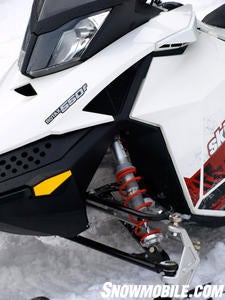 Modest shock packages on the three fan-cooled “value” sleds hold down the price.
Modest shock packages on the three fan-cooled “value” sleds hold down the price.
As we noted, each of these three sleds draws its ride from the latest chassis and suspension packages in their respective lineups. That means the Arctic Cat features a double wishbone front end based on Arctic’s seventh generation AWS VII standards. The F570 gets good but not great tube shocks. There is a standard equipment sway bar, which does help the side-to-side stability when jammin’ in the corners. The Polaris Shift 550 draws on the latest IQ technology, but adds RydeFX MPV shocks, which work pretty darn well considering that this sled retails for US$5,999! The Ski-Doo MXZ TNT 550 also has dual A-arms and like the Polaris gets a respectable shock package of rebuildable aluminum HPG Plus shocks.
The maximum travel for each sled’s front end differs by an inch from minimum to maximum. The Ski-Doo offers 9.0-inches of travel while the Polaris front-end works a full 10-inches. Arctic Cat’s F570 marks a compromise at 9.5-inches. On the trail we felt the Arctic Cat front bit best overall, but we’re talking small degrees here, not a huge difference between the three.
At the rear, the three sleds reflect top suspension engineering as well, although, again, the shock packages are more modest. The Cat uses torsion spring and tube shock modulation to control the slide-action design. Polaris’ Shift 550 bases it ride on the IQ skid frame, which is controlled via RydeFX MPV shocks on the front and rear suspension arms. The SC5 Ski-Doo slide rail suspension offers up to 15-inches of travel controlled by HPG Plus shocks. The F570 gives 13.5 inches of travel and the Shift 550 comes in at 13.9 inches.
Frankly, we don’t have a favorite here. They all offer very good ride for the dollars invested.
The Differences
We would say that your decision might simply come down to brand preference or saving a few bucks. The Polaris Shift 550 in basic black trim costs the least at US$5,999. The pricing is a bit deceptive in that the Shift styling package is truly a do-it-yourself concept. You can opt for a decal pack to give the sled a customized look. These are available from the Polaris parts and accessories catalog. Go figure!
We like the Shift from a performance standpoint. Like most IQ models it handles well, but we don’t care for the straight and what we feel is too low handlebar setting. Again, there are add-on options available.
All controls are logical and easy to reach. This sled will handle well on ungroomed trails, but is most at home on groomed ones. It will corner well enough for you to wish that you had spent more for a bigger motor, but it is light enough to toss around and its Phantom hydraulic disc brake will mask any errors.
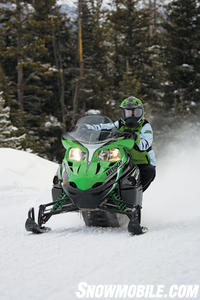 With good bite in the corners, the Arctic Cat F570 challenges more powerful sleds in the twisties.
With good bite in the corners, the Arctic Cat F570 challenges more powerful sleds in the twisties.
The Arctic Cat F570 (US$6,699) dropped some weight from last year to this one. That should make it a bit more responsive based on an improved power to weight ratio. Like all Arctic Cat models, the nifty curved handlebar setup gives this sled an edge in riding comfort versus the Polaris and Ski-Doo. There is storage room available as Arctic Cat engineers added an integrated storage pouch at the rear of the redesigned seat, which is eight pounds lighter than the previous design.
Amazingly, the Ski-Doo MXZ TNT 550 (US$6,949) is not the lightest Ski-Doo sport sled. Even though this fan-cooled version is the lightest of the fan-cooled models here, it actually weighs three pounds more than the liquid-cooled TNT 600, which is also on the new REV-XP chassis! Still, the fan-cooled TNT will surprise you on the trail with its incredibly light and nimble feel. You can have a lot of fun kicking this sled into and out of a turn. But, as with the Polaris, we are not keen on the straight handlebar. But we are pleased that the Ski-Doo’s REV design made the competition come up with its own ride-forward chassis designs. That fact alone makes any of these three value-priced sport models worth a look.
Let’s be honest here. If you ride with a group that favors liquid-cooled sport sleds, the modest power of these fan-cooled models will have you taking “sweep” on most rides. That is, until you hit the real twisty sections. That’s where these three sleds gain respect. They are as quick as most liquid-cooled models in tight sections. A good rider on one of these fan-cooleds can keep up, if not out right stay ahead, of heavier, more powerful sport riders in the tight trail sections. Long straights are another story altogether. Regardless of the trail, these three sleds offer great value, fun riding and a flashback to the early days when air-cooled engines ruled.
| 2010 Arctic Cat F570 | 2010 Polaris Shift 550 IQ | 2010 Ski-Doo MXZ TNT 550 | |
| Engine | Arctic Cat/Suzuki 565cc twin cylinder; fan-cooled; 2-stroke; two Mikuni VM 34 carbs | Polaris Liberty 544cc twin cylinder; fan-cooled; 2-stroke; two VM34 Mikuni carbs | Rotax 553.4 twin cylinder; fan-cooled; 2-stroke; two VM30 Mikuni carbs |
| Horsepower | 50-plus | 50-plus | 50-plus |
| Drive | Arctic driver/Arctic roller cam driven | Polaris P-85 drive; P2 driven | TRA III drive & matched driven |
| Front Suspension | Arctic AWS VII A-arm with tube shocks and sway bar; 9.5-in maximum travel | Polaris IQ — 10-in maximum travel; RydeFX MPV shocks | Dual A-arm — 9.0 inch maximum travel; HPG Plus aluminum rebuildable shocks |
| Rear Suspension | Arctic slide action skid rail; torsion spring and tube shock; 13.5-in of maximum travel | Polaris IQ — 13.9-in of maximum travel; RydeFX MPV on front and rear arms | SC5 — 15-in of maximum travel; HPG Plus aluminum rebuildable shocks on front and rear arms |
| Length | 118.0 in | 115.0 in | 113.8 in |
| Width | 48.0 in | 48.0 in | 47.9 in |
| Height | N/A | 48.5 in | 39.4 in |
| Ski Stance | 43.0 in | 42.5 in | 42.4 in |
| Track | 15 x 128 x 1.0 | 15 x 121 x 1.0 Shockwave | 15 x 121 x 1.25 Rip Saw |
| Weight | N/A | 470 lb (claimed) | 411 lb (claimed) |
| Brake | Hydraulic | Polaris Phantom hydraulic | Brembo hydraulic |
| Features | Electronic reverse | Electronic reverse | Electronic reverse |
| Fuel Capacity | 10.8 US Gal | 11.5 US Gal | 10.6 US Gal |
| MSRP | $6,699 | $5,999 | $6,949 |
| Full Specs | Here | Here | Here |
Related Reading
2010 Polaris 550 IQ Shift Review
2009 Arctic Cat F570 Review
2009 Ski-Doo MX Z 550X Review
2009 Ski-Doo Skandic SUV 550F Review



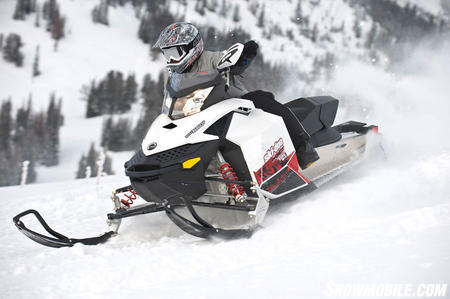
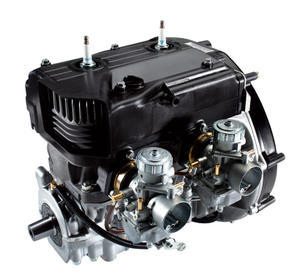
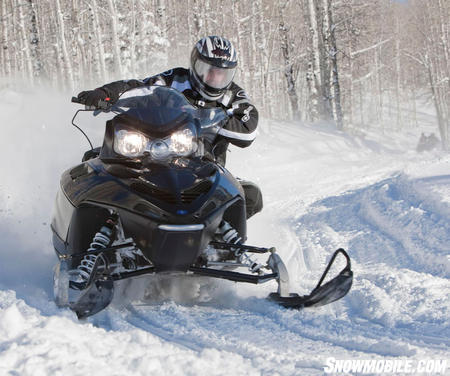
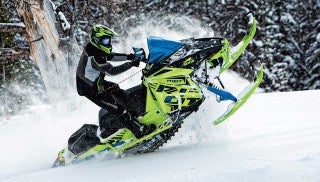
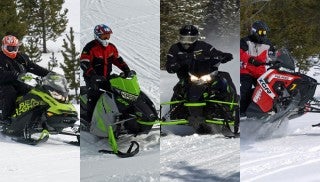
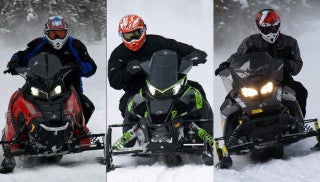


 Your Privacy Choices
Your Privacy Choices